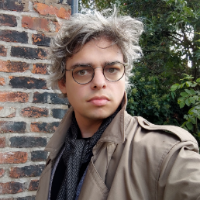In 1973, an unusual score appeared in the journal Soundings. Usually a publication concerned with contemporary music, this piece was different: it dated to 1938. Presented without commentary, it was written by a then almost entirely unknown composer, Johanna Beyer.
Music of the Spheres calls for three “electrical” instruments – the specific type not determined. It is one of a tiny handful of scores written in the 1930s for electronic instruments, and the first written by a woman composer.
If performed in the 1930s, the piece could have been played on ondes martenots, or theremins, or some other analogue synthesisers. The piece was in fact intended to be the opening to a sprawling four-act music-theatre work, titled Status Quo. With a scenario by the composer herself, the drama is set over multiple continents, with music, singing, narration and film projections. (The piece was never produced, the Guggenheim Foundation rejecting her proposals for funding in 1939.)
Johanna Magdalena Beyer was born in Germany in 1888. Emigrating to the United States in 1927, almost nothing is known about her early life. From 1930, she enrolled in the New School for Social Research, studying with and befriending Henry Cowell, Charles Seeger, Ruth Crawford and others from the New York scene of the 1930s. She would become a lifelong friend and advocate of Henry Cowell – an advocacy only hesitatingly reciprocated by Cowell himself.
Despite her association with figures of interwar US ultramodernism, her own music is singular, and can be quite different from that of her peers. She was not a composer with an outside source of income: she had to work, mostly as a piano teacher, and was often in significant poverty. (After 1936, she also worked for Cowell himself, handling his affairs during his incarceration in San Quentin prison.) For these and other reasons – her gender, her status as an immigrant, and perhaps most of all, the strangeness and singularity of her music, and a certain lack of advocacy from even her closest musical friends – Beyer’s music was not much heard in her lifetime. The first concert entirely dedicated to her music occurred in 1988, more than forty years after her death.
Yet Beyer’s music is extraordinary, and greatly anticipates later developments in 20th-century music. It is often minimal, operating with extremely simple and direct material. It can be both plain and otherworldly. Some of her music is spare and austere, at other times strange and almost alien, with incessant glissandi and repetitions. Her music can be jaunty too, and makes use of folk-like tunes, or even quotations from Mozart, as in the first and last movements of String Quartet no. 2. These aspects can lend her music a quietly whimsical quality.
Performances of Beyer’s music in Europe are rare. But on 12th May, the Italian composer Cristiana Palandri is convening a performance at LAC Lugano, together with violist Chiara Ludovisi and pianist Bruna Di Virgilio. Alongside several of Beyer’s works, four newly written pieces will be presented, for acoustic instruments and live electronics, some involving video projections and sound sculptures. Presented alongside Palandri are the composers Teresa Carrasco, Rachel Beja and Gaia Aloisi.
“Ten years ago, when I first encountered her music,” Palandri tells me, “it was obvious that it represented an early meeting point between classical and electronic music. That’s one of my obsessions – to make such meeting points visible. At that moment she became an important figure, who altered my musical path. This event is a letter to her – and of course she was a woman, so as a woman composer it is even more resonant, for obvious reasons.”
Beyer’s output was multifarious. (“I am not a set piece of so many molecules. I am an ever changing something”, she wrote to Henry Cowell in 1940.) Beginning in the early 1930s, she composed a number of works for piano, a variety of chamber music for winds, vocal works (including for chorus), and a panoply of works for percussion ensemble. (Four movements of her five-movement suite Percussion, above, were only rediscovered in 2011.) Her four string quartets are among the finest quartets written by any American composer. She also wrote works for larger ensembles, including several works for orchestra. Many of these have never been performed.
“Sometimes, if I want to be optimistic,” Palandri says, “I think that you can have a lot of freedom, not being in the spotlight: you can experiment. You are free to try to do whatever you want, without too much judgment. On the other hand, it is extremely frustrating to live in the shadow of other composers.”
Beyer had an optimistic and determined worldview, and was opposed to the injustice she saw around her – unsurprising given the considerable hardships and barriers she faced in her lifetime. This outlook was formed early after her emigration to the US, through contact with a variety of socialists and leftist activists in Sunnyside, Queens. It is in evidence in her choral and vocal output, which sets texts from writers Carl Sandburg and Bonaro Overstreet. (Bonaro and Harry Overstreet, both writers, were also campaigners for adult education and mental health.) “Have Faith!”, an extraordinary poem written shortly after Henry Cowell’s incarceration in 1936, gives a sense of this worldview:
Have Faith!
Here is a song for you,
oh, nightingale!
a song of what!
of hope, of future, present, past?
it does not matter, it does not matter.
But essential is,
that you and I and all the others
have faith in things to come,
in things that passed, and are
and we must try to understand
and love and help each other,
have faith in things to come,
have faith!
The scenario for Status Quo mirrors this future-oriented worldview. With the first three acts of the work depicting variously the US, the North Pole, England, France, the USSR, China, India, Africa, Fascist Germany, Italy and Spain, the last act of the drama was to be set in Geneva. Beyer’s intentions for the conclusion to the work are clear from her draft of the opening narration: “just before having another glimpse of eternity, people from all these countries will unite in a dance. Tolerance and cooperation will be the motives. The music to this dance is an attempt to unite features of different music systems to a rather substantial harmonious whole.”
Beyer’s proposal for Status Quo attracted a variety of responses from figures asked to evaluate her work. Writing from San Quentin, Henry Cowell provided an evaluation describing her “great natural talent … with a flare for whimsical and original ideas” – yet he still recommended the Guggenheim fund a different (male) composer. Ashley Pettis, the director of the New York Composers’ Forum, gave her a glowing recommendation, as did Harry Overstreet and composer Ruth Hannas. But Roy Harris, despite knowing practically nothing of her work, declared: “To create new operatic idioms is a life work requiring great talent, resourcefulness and experience with the orchestra, the voice (as solo and chorus) and experience with music in relation to the theatre. … Such equipment I cannot honestly say that I believe Miss Beyer to be possessed of.”
It is notable that Beyer’s male advocates came from outside the world of music. One of her most ardent supporters was theatre designer Erdix Winslow Capen, a friend of Beyer’s from Sunnyside, Queens. He wrote: “She seems to be way ahead of most of her contemporaries in her thoughts of music and its place in the world. … I feel certain that given the wherewithal and the chance to work it out she will rise to heights that she has thus far been unable to reach because of lack of funds to tend to her needs while she worked. … I am thoroughly convinced from what I have heard of her work that she is as near a genius as I am ever likely to meet up with.”
Despite Status Quo’s rejection, Beyer continued to write large scale works through the later 1930s, including for symphony orchestra. She composed 11 works for large ensemble in all. One of them, CYRNAB, has a title derived anagramatically from her and Henry Cowell’s names (it was given a world premiere only in 2019). Other pieces, for wind ensembles, were written at the encouragement of Percy Grainger, who did find time to give them rehearsal try-outs. She corresponded with many well-known conductors of the period – including among others Serge Koussevitzky, Fritz Mahler, Pierre Monteux, Nicolas Slonimsky, Leopold Stokowski and Hans Lange, the last of whom she dedicated the beautiful Fragment for Chamber Orchestra (above). None expressed any interest in her music.
By 1941, Beyer’s health was rapidly deteriorating – she was suffering from ALS (Lou Gehrig’s disease). At this time Henry Cowell took the opportunity to extricate himself from her friendship. Despite Beyer’s entreaties not to abandon her, and of her love for Cowell, he told her in June 1941, shortly before her hospitalisation, that he did not love her and “that it is best for us to discontinue contact altogether.” Beyer’s last letter to Cowell lamented his eventual callous lack of advocacy, and that despite having composed “over 100 works”, including pieces for orchestra, and sending them to everyone who apparently mattered, she still had “no chance to hear one of them!”
After her death in 1944, Beyer’s music was stored for many years in the archives of the American Music Centre in New York, before being transferred to the New York Public Library, where it remains today. It has been only since the 1970s that interest in her music has returned in earnest. Since that time, changes in musical taste and the advocacy of composers and scholars – such as Larry Polansky, Amy C Beal and Melissa J de Graaf – have allowed the unique music of this singular composer to be more readily understood and appreciated.
Cristiana Palandri (live electronics), Chiara Ludovisi (viola) and Bruna Di Virgilio (piano) present Letter to Johanna Beyer at LAC Lugano on 12th May, featuring new music by Palandri, Teresa Carrasco, Rachel Beja and Gaia Aloisi.
Amy C Beal’s biography of Johanna Beyer (2015) is published by University of Illinois Press.
This article was sponsored by Fondazione LuganoMusica.




